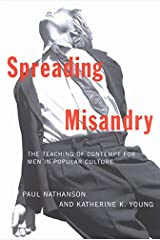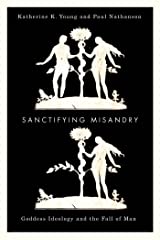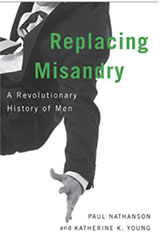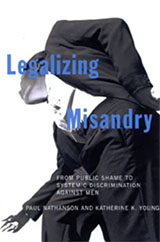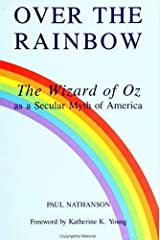By Paul Nathanson
Yesterday was a fine spring day. On my way out for the afternoon, I saw some yellow tulips shyly lifting their heads to the sky and the first bright and feathery leaves unfolding on branches. And yet I spent the afternoon indoors at a movie. It’s about the decline of manhood and therefore should be of great interest to everyone who cares about men. Here’s a synopsis of The Rider (Chloé Zhao, 2018).
Its setting is a Lakota reservation in the “badlands” of North Dakota. Brady is a beautiful young man, who loves horses and can’t imagine a life without caring for them and riding them. He lives in poverty with his retarded younger sister and widowed father. But Brady has a big problem, and it isn’t poverty. It’s the result of falling from his horse during a rodeo. Even with a metal plate in his skull, he still has seizures now and then. One symptom is his right hand, which clenches uncontrollably and makes it impossible for him to use the reins effectively while riding. For a while, Brady maintains the hope of recovering fully and makes a little money by taming the local wild horses. When that proves too difficult, he gets a menial job in the local supermarket. Nonetheless, he enjoys being with two friends and visiting a third friend in hospital. Lane has had a similar fall but been much more severely wounded. He can neither walk nor speak. But Brady’s visits to the hospital always leave Lane more cheerful than he usually is. The great love of Brady’s life is Apollo, however, his ill-fated horse, Eventually, Brady realizes that he will never be able to live his dream and enact his identity. His ultimate fate remains unknown as the closing credits roll.
The Lakota in this movie reveal deep ambivalence about their identity. On the one hand, they’re Americans. They speak English (when they speak at all, which is not often) and have English names. Brady and his friends call themselves “cowboys” (certainly not “Indians”). As in “western” movies, they adopt “cowboy” costumes (notably big black or white hats), use saddles on their horses (instead of riding bare-back) and perform in “cowboy” rituals (such as rodeos). At dusk, sitting around campfires on grassy meadows and watching the sun dip below the long horizon, they play their guitars and sing “country” songs. These people are Christians, moreover, which is why Brady’s mother lies in a graveyard with many crosses.
On the other hand, these people are unlike other Americans, even other western or poor Americans. They retain at least some sense that manhood was once a noble calling. (And I’m not referring merely to the poster in one scene that urges readers to believe that “the Lakota way is a good way.”) Brady and the other men in this movie, for instance are capable of caring for each other and even of compassion. Brady loves his sister and acknowledges his need to protect her. His seemingly laissez-faire father sacrifices his own desires in order to buy a horse for his son and later shows up at the rodeo to cheer him on (after angrily warning Brady to heed medical advice). Like many American men, it’s true, these dudes have emotional lives that they express most intensely in gestures or even silence rather than words. In one scene, Brady weeps privately over his fate. In another scene, he and his friends hug each other. Unlike many other American men, though, these men are very careful about expressing one particular emotion. Of interest here is their passivity, which contrasts with the rage of many other poor communities. Neither, of course, is characteristic of a healthy collective identity. I’ll return to that in a moment.
Historic versions of masculinity, including the traditional Lakota version, have become vestigial. The lives of Lakota men still revolve around horses, to be sure, but that very fact isolates them from modernity and makes them living anachronisms. These “riders” might sell a few horses to ranchers or tourists, for instance, but their only real opportunity to earn money is by performing at rodeos: modern rituals with nostalgic value but no economic (or military) value. These ceremonial events can no longer function as a coming-of-age ritual for boys, at any rate, because preparing for them doesn’t equip them with the knowledge or skills that would ensure communal survival. (Rodeos are thus like the jousting tournaments in late-medieval Europe—that is, long after jousting had lost any relation to the dissolving feudal system. By that time, tournaments had come to focus on the preservation of aristocratic status, symbolically, at a time of increasing social mobility due to the revival of trade and commerce.) Consequently, the boys remain boys. As everyone knows by now, this is precisely the fate of so many boys in all modern, or postmodern, societies.
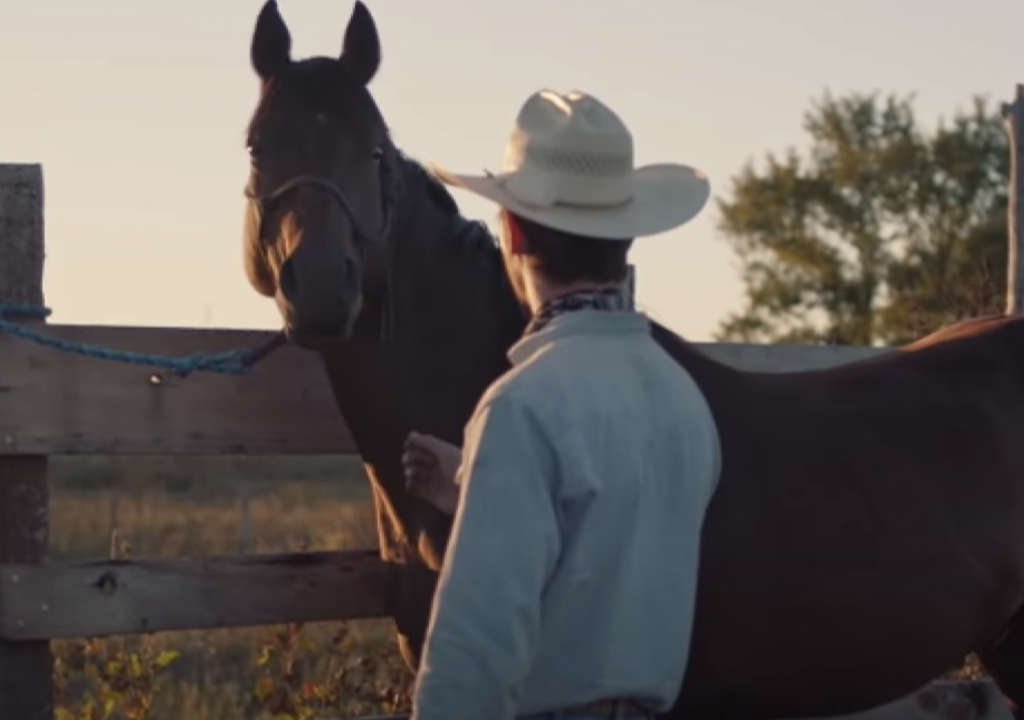
Not surprisingly, The Rider includes both explicit and implicit references to death. Brady visits his mother’s grave in an early scene, for instance, where he prays to, for and somehow with her. Toward the end, moreover, Apollo is wounded and must be “put down.” Brady says that his own fate would be the same as Apollo’s if he had been a horse; being a man, he must (lamentably) live with his wounds no matter how crippling they are. And yet he clearly tries to kill himself by riding in another rodeo and thus rejecting the warnings of his physician. Other references to death, however, are implicit. The cinematography features North Dakota’s beautiful landscape—flat, bleak and largely empty but also open to infinity both horizontally and vertically. (Could that suggest eternity as well? Possibly.) I found it distinctly sad. How long will this wilderness survive the onslaught of urbanization, industrialization—and now, judging from the garbage and abandoned machinery that litters parts of the landscape, de-industrialization? I found the background music equally beautiful and sad. It, too, is elegiac and almost funereal.
At the surface level, this movie is about the fate of one young man and his friends. At a deeper level, it’s about the fate of all men on their tribal reservation. Every major character and almost every minor character, after all, is male. And at a still deeper level, it’s about the fate of manhood in American society society. Instead of heaping shame and contempt on these faltering and vulnerable men and therefore on men in general, Chloe Zhao has written and directed what amounts to a requiem for manhood. Why would she choose to do so in the specific context of tribal men? It’s because tribal societies have long been symbols for so many other Americans of decline, defeat, marginality and therefore of “death.” Zhao refrains from reminding viewers of the many social problems that afflict these peoples (including those of the Pine Ridge Reservation, where she shot this movie with non-professional actors). Her goal is not to study this community, so The Rider is not (fortunately) a sociological or anthropological treatise in the cinematic form of a story. Rather, her goal is to mourn the decline and distortion of masculine tradition in modern societies. The whole movie functions as an epitaph. I’m thinking of what Linda tells her son Biff in Death of a Salesman: “I don’t say he’s a great man. Willy Loman never made a lot of money. His name was never in the paper. He’s not the finest character that ever lived. But he’s a human being, and a terrible thing is happening to him. So attention must be paid. He’s not to be allowed to fall into his grave like an old dog. Attention, attention must be finally paid to such a person.”
Once upon a time, though, masculinity was not some historical anachronism or anthropological curiosity. It was a distinctive, necessary and publicly valued way of life. This morning, by chance, I watched an earlier cinematic exploration of manhood in trouble. In The Best Years of Our Lives (William Wyler, 1946), three soldiers return from combat in World War II and try to pick up their lives again but find that they have to start all over. Originally, this movie was Hollywood’s attempt to comment on a current social problem: the re-integration of veterans after years of combat. Watched now, though, after more than seventy years, Best Years is even more disturbing and more moving than it ever was.
Of the three returning soldiers, only one seems destined, at first, to succeed in peacetime. Before the war, Al had been a happily married man of the upper middle class. His wife and daughter greet him with joy. He can begin right away, therefore, to resume his old life. He steps back into his job at a bank. The war has not changed that. It has, however, changed Al. When another former soldier comes to his office and asks for a loan, Al is delighted to help him start a business—even though the younger man lacks collateral. Al’s boss is less than pleased. He’s interested only in making money on secure loans, not in rewarding patriotism or gambling on the youthful ambition that has made America the land of opportunity. But Al’s wife does understand what the war has done to him and supports his idealism.
Before the war, Fred had been materialistic and hedonistic. Not surprisingly, he had married someone with the same outlook. But the war has changed him no less than Al. He returns with no money, no job and no idea of what would give meaning to his survival in combat. To make ends meet, he takes the only available job and becomes a soda jerk at the local drugstore. Trouble is, his wife wants only to live it up as if no war had intervened—and if not with Fred, then with some other man.
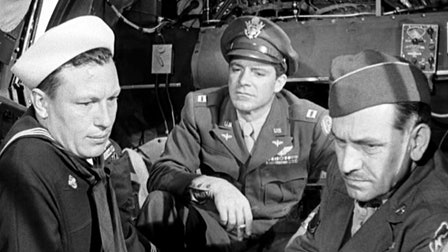
Before the war, Homer had been a happy-go-lucky boy whose thoughts about the future extended only to marrying the girl next door and living happily ever after. But the war has changed him even more than the others. Homer’s hands have been burnt off in combat, leaving him with steel hooks to replace them. Although he has learned how to use these effectively, he has trouble adjusting to public curiosity and, even worse, pity from his girlfriend—even though she has both the undiminished love and the courage to marry him anyway.
All three men, as I say, have endured years of suffering as soldiers in wartime, the ultimate proving ground in their world of manhood. Each manages to re-invent himself as a man according to universally accepted virtues of masculinity, which they can re-affirm along with everyone else—despite its heavy price. These virtues include not only courage and self-sacrifice but also integrity, honesty, generosity, tenacity, compassion and faithfulness (virtues not limited to men except for their particular manifestations in daily life). One scene is particularly moving in this respect. At the soda fountain, a cynical middle-aged man tells Homer that the war had been unnecessary—and so had the sacrifices of so many young men like Homer himself, who have ended up either dead or mutilated. Homer rejects this point of view as a matter of honor, and Fred, who overhears the conversation, comes to his aid by slugging the stranger (thus losing his lowly job at the soda fountain).
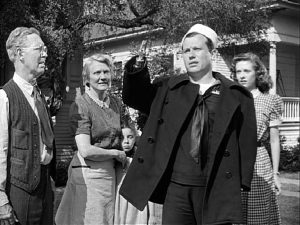
Best Years is not merely a sad story, not for me. As a refugee from the mid-twentieth-century, I allowed my eyes to linger on its costumes and sets. More important, I allowed my mind to explore its beliefs about how families and communities work, especially its beliefs about manhood. Those things came from another world, one that I had known intimately long ago. It was the world of my childhood, the one that my parents bequeathed to me with all of their love and hope. Nothing is left of it now, nothing but ruins—that is, relentless rage and pervasive cynicism. No wonder my dead parents continue to haunt me. You could say that I feel “nostalgic,” but that word, despite its etymology, has come to connote something superficial, misguided or even shameful. What I am, truly, is intensely homesick (which says something about a man who was intensely unhappy as a child almost everywhere but at home). I want desperately to live once again in a world that, despite its terrible flaws (such as war, class conflict and racial segregation), made sense at least as a shared and uniting ideal. At home, I had both unconditional love and earned respect. More important, I understood that men and women actually needed and tried to support each other.
I feel now like Dorothy in The Wizard of Oz. Captured in a witch’s gloomy castle, she looks into her captor’s sinister crystal ball and sees the farm back in Kansas. Sick with worry, Auntie Em is calling out for her. In the gloomy castle, though, Dorothy looks around her in despair and says, “I’m frightened, Auntie Em, I’m frightened.” And so am I but not only for myself. What, I ask myself over and over, am I doing here? How did we all get here? What went wrong? Is there really nothing left that’s worth fighting or even dying for? Those are not only historical, anthropological, psychological, political or even moral questions. Considering the rapid fragmentation of our society into a seething collection of polarized identity groups, these questions are also existential ones.
This brings me to what I’ve been saying for years about the problem of manhood today: the inability of men, at least so far, to create a healthy identity for themselves (as distinct from allowing women to create an unhealthy one for them). A healthy identity emerges from and fosters at least one distinctive, necessary and publicly valued contribution that men can make specifically as men to society. (Fatherhood is possibly the only remaining source for a healthy collective identity, and that has already been trivialized and even demonized beyond recognition.) Failing to establish a healthy identity, more than a few men succumb to either passivity or rage—or both. This is true of more and more young men not only individually but also collectively. These stats don’t lie. Some abandon a society with no room for them as men; they give up, drop out or kill themselves. Others turn against society, believing that even a negative identity is better than no identity at all; they kill themselves, too, and sometimes (in the context of personal psychopathology) take others with them.
My point here is not merely to eulogize masculinity as I knew it in my own youth. That gender paradigm had its flaws, notably its association of maleness with what Warren Farrell calls “disposability.” Being gay when homosexuality was considered either immoral or sick, moreover, I was a victim of both boys and girls who had no understanding of masculinity (or femininity) and therefore no way of placing conventional markers of gender within larger cultural, historical and moral contexts. They bullied me relentlessly because I was different from them, but I could have been equally different in connection with religion, ethnicity, class, language and so on.
My point here really is, however, to assert that masculinity per se (not this or that version of it) is more than some arbitrary or oppressive “social construction,” let alone one that originates in the sinister motivation of men to “dominate” women. If I’m correct, then we’re not quite free to abandon it as a disease to be cured in accordance with this or that fashionable ideology. Rather, as I now see after many years of denial, masculinity of one kind or another is a universal feature of human societies (no matter how minimal any gender system might be in some cultures).
To put it bluntly, I don’t believe that our society can continue to pathologize or demonize just about every feature of masculinity (or even maleness itself) without continuing to destroy the personal and collective identities of half the population.
I’ll conclude with a sad comment on manhood in my own environment. Long ago and in a galaxy far away, the ideal Jewish man was (and still is in some communities) a Torah scholar. For Life Is with People, sociologists Mark Zborowski and Elizabeth Herzog interviewed Jewish women from pre-war Eastern Europe. Asked what made men look sexy, the women agreed that men should look pale and thin—as if they could afford to spend entire days in the synagogue praying and studying rabbinic commentaries on the Torah. Translated into secular terms, the ideal Jewish man became a doctor, a lawyer or an academic. Without the spiritual matrix, however, the Jewish ideal differed little from the ideals of many (but by no means all) other communities. It became a very effective way to climb out of poverty and rise in status. That worked for two or three generations, but it doesn’t work so well now. Apart from the Hasidim and other ultra-orthodox Jews, Jewish men today face the same problems as those of men in general, let alone Lakota men: cultural indifference, ideological hostility and, most important of all, vocational obsolescence. What replaced the traditional Jewish ideal animates bitterly satirical novels by authors such as Philip Roth and Mordecai Richler. No ideal of manhood, in short, has escaped erosion and distortion.
2 June 2018
© 2018 Paul Nathanson
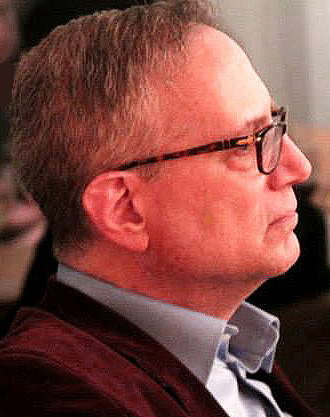
Paul Nathanson has a BA (art history), a BTh (Christian theology), an MLS (library service), an
MA (religious studies) and a PhD (comparative religion). Of particular interest to him is the
surprisingly blurry relation between religion and secularity: how religious patterns of thought
underlie seemingly secular phenomena such as classic movies (such as The Wizard of Oz) and
political ideologies (notably feminism and wokism). With Katherine Young, he has written a
series on the problem of masculine identity in this polarized environment. These volumes include
Spreading Misandry: The Teaching of Contempt for Men in Popular Culture; Legalizing Misandry: From Public Shame to Systemic Discrimination against Men; Sanctifying Misandry: Goddess Ideology and the Fall of Man; and Replacing Misandry: A Revolutionary History of the Male Body.
The fifth and sixth volumes are not yet published: Managing Misandry: Men’s Voices on the Meaning of Manhood and Transcending Misandry and Misogyny: From Feminist Ideology to Intersexual Dialogue.
